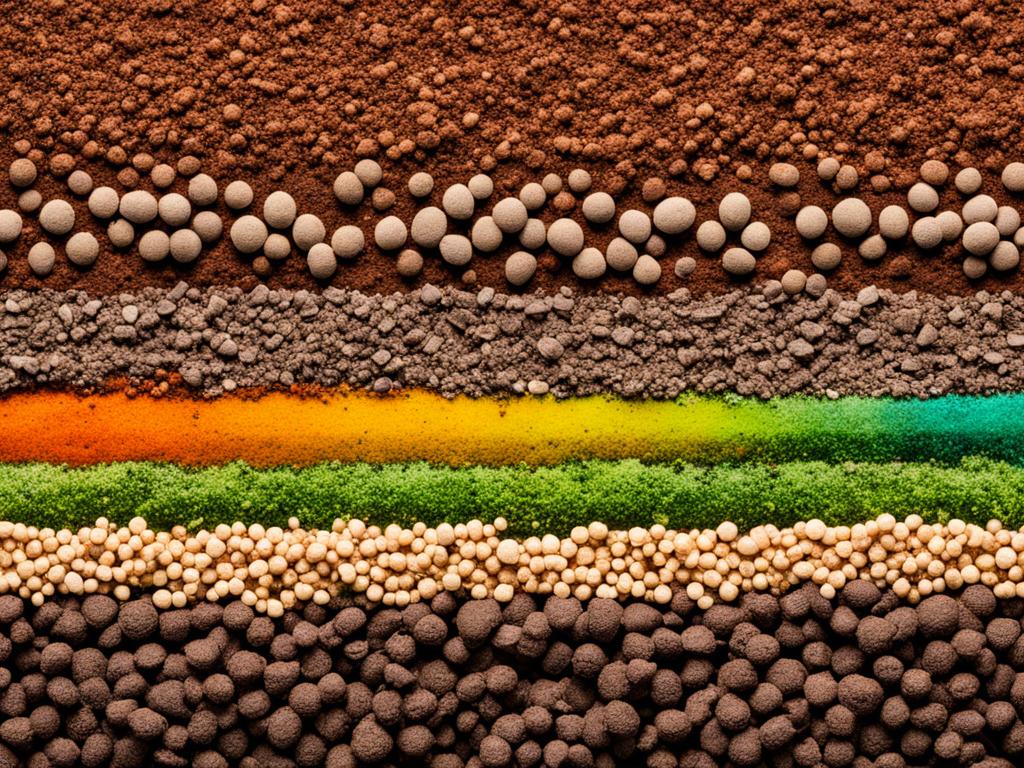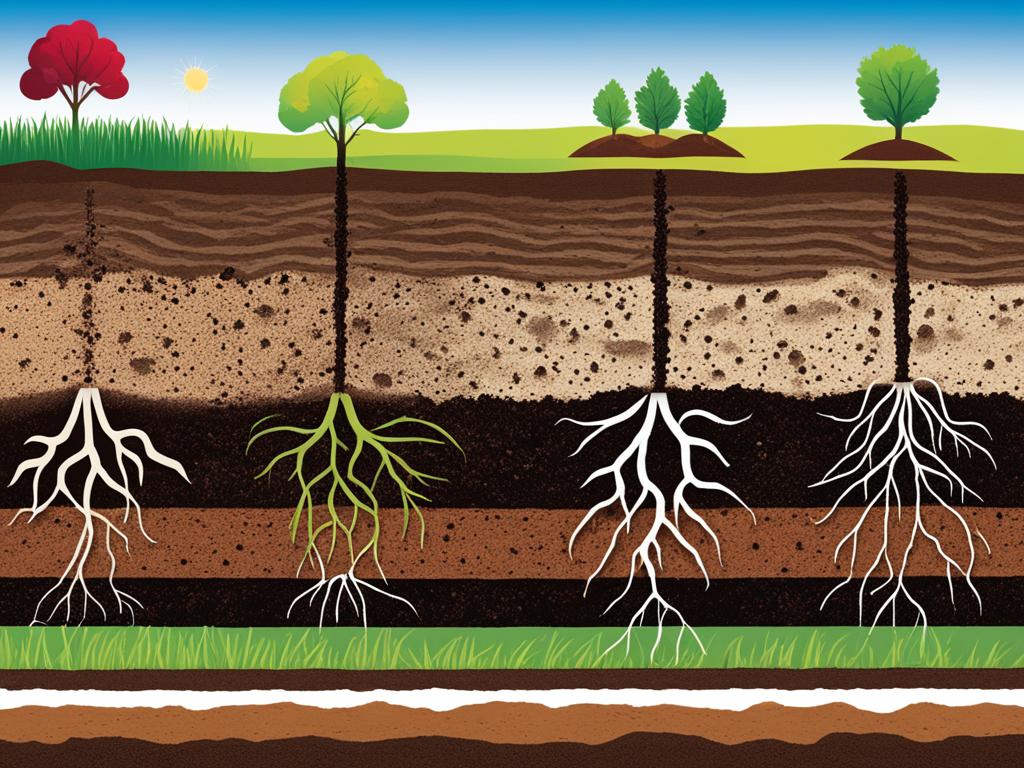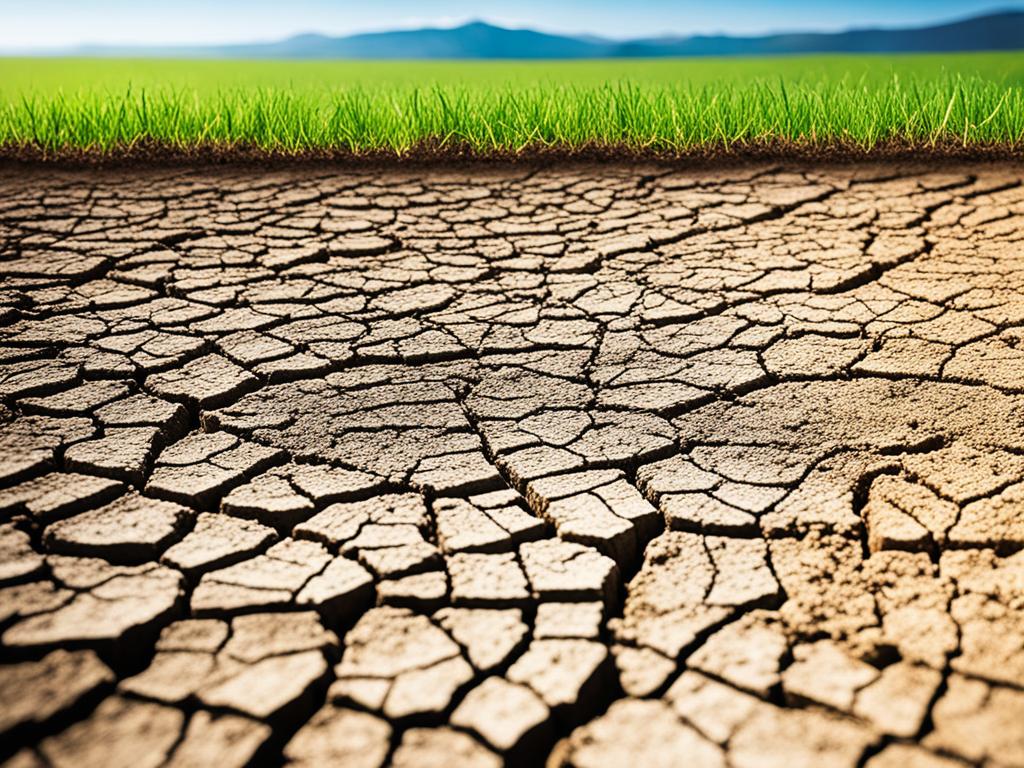Soil is crucial for life on Earth. It’s a key part of the Earth’s biosphere. Soil helps with many important things, like filtering water and supporting plant growth. This makes it vital for our world.
Soil science studies how soil works. It uses ideas from physics, biology, and chemistry. This helps us understand the relationships between soil, plants, and the environment. Knowing about soil helps us farm better, protect nature, and fight big issues like food security and climate change.
Soil is more than dirt under our feet. It’s a natural water filter, cleaning water for us. It also feeds the plants we need to live. Plus, soil is home to many tiny living things. They help make medicines and keep ecosystems diverse.
Soil is also key for farming. It’s where crops grow to feed us and provide materials. Soil science is important for smart farming and protecting our environment. It ensures we can keep producing food without harming the Earth.
Key Takeaways
- Soil is a vital natural resource. It does important jobs like filtering water and supporting life.
- Soil science uses different sciences to understand soil, plants, and the environment better.
- Soil scientists study soil to help with farming, protect nature, and farm in sustainable ways.
- It’s crucial to know about soil to fight food security, keep water clean, and handle climate change.
- Good soil management is key. It means farming in ways that keep soil healthy without hurting the planet.
Importance of Soil Science
The foundation of agriculture and ecosystems is the soil. It plays a major role in keeping life going. The soil does a lot. It cleans our water, helps forests and crops grow, and controls the Earth’s temp.
Today, we know how important the Earth’s natural systems are. So, new ways to protect them are popping up. Markets for trading biodiversity, carbon, and water are growing. Examples include the Chicago Climate Exchange and the Chesapeake Bay’s nutrient trading.
These markets give value to ways that improve ecosystem services. They make products that are good for us and the environment.
Soil Filters Water and Provides Nutrients
Soil is key in keeping our water clean and feeding plants. This role helps make sure our food and fuel sources can keep going. It’s crucial for our society’s needs.
Habitat for Biodiversity
Soil is home to many tiny creatures. They play a big part in keeping our lands healthy. Soil experts look into how we can protect this life. They use advanced farming methods to keep the soil’s biodiversity.
Foundation of Agroecosystems
Soil is the bedrock of farming and life systems. It’s essential for producing food, feed, and fiber. Scientists look for ways to farm that keep the soil and our resources strong.
Soil Composition and Properties
Soil’s makeup and features are vital in understanding its role in the environment. The organic matter in soil improves its structure, ability to hold water, and how it cycles nutrients. These are key for farming success and keeping our ecosystems healthy.
Soil Organic Matter
Soil’s organic matter shows how good the soil is for farming. It comes from things like old plants and animals breaking down. This makes soil better at holding water and nutrients, which helps plants grow. Soil with lots of organic matter is often very fertile and supports strong plant life.
Soil Structure and Texture
The way soil is shaped and feels affects how water, air, and plant roots move through it. It’s based on how much sand, silt, and clay there is. Sand lets water through quick, but clay slows it down. Knowing your soil type is key for watering plants right and helping them grow well.
Soil pH and Nutrient Availability
Soil’s pH level impacts which nutrients plants can use. Most plants like a little acidity or neutral soil, around 6.0 to 7.0 pH. The right pH level helps plants take in important nutrients. Adding lime or sulfur can adjust the soil’s pH, making nutrients more available for plants. This supports their growth.

Nutrient Cycling and Soil Fertility
Nutrient cycling is key to soil’s health and the success of both natural areas and farms. The nitrogen cycle and phosphorus cycle are very important. They help plants grow strong. Soil microorganisms change nutrients in the soil into a form that plants can use. Knowing how nutrients move and change is vital. This knowledge helps in farming that is good for the land and grows big harvests.
Nitrogen Cycle
The nitrogen cycle is all about the changes nitrogen goes through in soil. These changes include nitrogen fixation and nitrification. Also, there’s denitrification, when nitrogen goes back to the air, and mineralization. Living in the soil, a mix of bacteria and archaea help with these changes. They turn nitrogen into forms like ammonium, nitrate, and atmospheric nitrogen. Keeping the nitrogen cycle in good shape is important. It helps the soil stay fertile without hurting the environment.
Phosphorus Cycle
The phosphorus cycle is all about how phosphorus moves from soil to plants and animals. Plants need phosphorus to grow well. It helps in energy transfer, growing roots, and making flowers. Soil has organic and inorganic phosphorus. Things like soil pH and texture, plus soil life, affect how plants can take up phosphorus. Knowing about the phosphorus cycle is key. It helps us farm in ways that use phosphorus well and don’t harm the planet.
Soil Science: The Foundation of Agriculture and Ecosystems
Soil science is all about how soils provide essential ecosystem services. It blends ideas from physics, biology, and chemistry. This helps us understand how soils work. Scientists in this field look at soil biogeochemical and physical processes and map soil characteristics.
They also teach others about soil. Soil scientists do many things. They look at different soils, plan how to use land, and check land quality. They also make sure soil is healthy, pick the best ways to grow food, and find ways to fight climate change. Their work aims to keep water clean and manage resources well. So, soil science is key to figuring out how soils, farming, and our planet all fit together.

Soil can be sorted by the stuff in it, like organic matter, nutrients, and minerals. These things affect how good the soil is at growing stuff. For example, sandy soil and clay soil are very different. They hold water and nutrients in different ways.
Bad things like erosion, compaction, and nutrient loss can hurt soil. This is bad for our food and the planet. Sustainable agriculture practices keep soil healthy. They stop erosion and keep nutrients where they need to be. This helps soil stay healthy and work well for a long time.
We need to talk about soil degradation to help. Sharing what we know raises awareness. It also helps us find answers to keep our soil healthy. Precision soil sampling services are part of the solution. They give us the right information for taking good care of soil in farming.
| Year | Publication | Findings |
|---|---|---|
| 2005 | “Soil Fertility and Fertilizers” by Havlin et al. | Soil fertility and the role of fertilizers in sustaining agricultural productivity. |
| 2007 | “Soil erosion and agricultural sustainability” by Montgomery (doi:10.1073/pnas.0611508104) | Impacts of soil erosion on the long-term sustainability of agriculture. |
| 2008 | “Water pollution by agriculture” by Moss (doi:10.1098/rstb.2007.2176) | The relationship between agricultural practices and water quality degradation. |
| 2010 | “The Nitrogen Cycle: Processes, Players, and Human Impact” by Bernhard | The importance of understanding the nitrogen cycle for sustainable agriculture. |
| 2011 | “Sustainable Agriculture” by Brodt et al. | Strategies for implementing sustainable agriculture practices. |
Soil Erosion and Conservation
Soil erosion is a big problem that affects farming and nature. It happens because of how we use the land, cutting down trees, letting animals graze freely, and because of bad weather getting worse due to climate change. These things can take away the productive top layer of soil, fill up our rivers with dirt, and make the soil not hold water well.
Causes of Soil Erosion
Bad farm practices like tilling too much, growing the same crop over and over, and using too many chemicals can ruin the soil’s health. Cutting down trees and letting animals eat up the plants means there’s nothing to protect the soil. Plus, the weather getting more extreme with heavy rains and droughts just makes everything worse.
Effects of Soil Erosion
Losing the good soil on top can hurt how well we can grow food and affect the creatures and plants that depend on the soil. When our rivers and streams get filled with soil, it makes the water dirty and can harm the animals living there. Also, if the soil can’t hold water, it makes us more vulnerable to droughts and not having enough water.
Soil Conservation Practices
But, there are ways to protect the soil. Methods like planting different crops to cover the ground, farming without disturbing the soil (no-till), and including trees and shrubs can help a lot. These practices help keep the soil where it should be and makes it healthier. By using these good ways of farming, we can keep our land working well for growing food and keep the natural world healthy.
Soil Biodiversity and Ecosystem Services
Soil is full of tiny organisms like bacteria, fungi, and archaea. These creatures are key in keeping ecosystems healthy. They have a big role in moving energy and nutrients around. This means they help with things like cleaning water, storing carbon, and supporting plant and animal life. Protecting these organisms is important for the earth to keep giving us what we need, both in natural areas and farms.
Microbial Diversity
There are loads of tiny life forms in soil. In just 1 gram of soil, you can find up to 1 billion bacteria. Plus, there are tens of thousands of other types of creatures. All these beings make up the soil food web. They work together to do things like recycle nutrients from dead plants or animals. This process is super important for our food production and the health of wild plants and animals.
Soil Food Web
The soil food web is a network of life in the ground. It includes tiny microbes, up to larger creatures you can see without a microscope. These beings help keep the soil healthy by recycling and moving around energy and nutrients. This web is the basis for the earth’s services to us, like clean water or air. Knowing how this web works is key for taking care of our earth and making it stay productive.
Ecosystem Services Provided by Soils
Both farms and wild areas benefit a lot from the earth’s ecosystem services. These include things like helping crops grow, regulating the climate, or creating new soil. When the soil has more kinds of life in it, it does a better job at these services. This is great news for both our farms and the wild places around us. It helps them stay strong and productive.
Soil Management Practices
Using sustainable and precise soil care is key for long-lasting farming and ecosystem health. These methods keep soil good, save resources, and fix damaged land.
Sustainable Agriculture
Cover crops, less plowing, and smart nutrient use are part of staying sustainable. They keep the foundation of agriculture and ecosystems strong by making soil better and keeping it healthy. Grasses and legumes protect soil and add organic matter, while using less plow keeps soil healthier. Wisely using nutrients makes the soil more fertile and keeps farms sustainable.
Precision Agriculture
Precision farming, like using variable inputs and smart sensors, is about using resources better. By applying fertilizers and pesticides only where they’re needed, it’s possible to make nutrient cycling work better. This makes soil fertility improve and lowers the harm to the environment. This kind of farming is better for the future.
Soil Remediation
When soils are harmed, special methods can help fix them. For example, phytoremediation and in situ stabilization can make contaminated soil healthy again. It’s important to use these ways to fix the soil, keeping our lands and ecosystems in good shape.
Climate Change and Soil Carbon Sequestration
Soils are key in the carbon cycle and can either help or harm us. Actions like farming, changing how we use the land, and messing with the soil can let out harmful greenhouse gases. But, we have ways to tackle this. No-till farming, using cover crops, and fixing up damaged lands can actually lock away carbon. This helps make the soil better, saves water, and keeps the whole environment healthier.
Greenhouse Gas Emissions from Soils
Soils are the heart of our farms and natural places, storing a lot of carbon – nearly 80% of all the carbon on land! Of this, there’s about 1,550 gigatons in organic form and 950 gigatons as inorganic carbon. This is compared to the 800 gigatons in the air. However, human activities can mess with this balance. They can disturb the soil’s natural ways, which releases harmful gases like carbon dioxide and methane into the air.
Soil Carbon Sequestration Strategies
We must improve how we manage soil to fight climate change. Methods like no-till farming and using cover crops can help store more carbon in the soil. This can make the soil better for growing food, save water, and support healthy ecosystems. When farmers and land managers use these methods, they’re not only helping the planet. They’re also making their land more productive and resistant to climate change.

| Statistic | Value |
|---|---|
| Total carbon in terrestrial ecosystems | Approximately 3,170 gigatons (GT) |
| Percentage of total carbon in soil | Nearly 80% (2,500 GT) |
| Organic carbon in soil | Approximately 1,550 GT |
| Inorganic carbon in soil | Approximately 950 GT |
| Atmospheric carbon pool | 800 GT, about 3.1 times smaller than the soil carbon pool |
| Soil storage rate of carbon from photosynthesis | Approximately 3 gigatons of carbon per year (GT C/yr) |
| Annual increase in atmospheric CO2 concentration | 0.88 parts per million (ppm) or 3.5 GT C/yr |
| Contribution of fossil fuel burning to atmospheric CO2 increase | Two-thirds of total increase |
| Contribution of land use change to atmospheric CO2 increase | Remaining one-third of increase |
Soil Science Education and Workforce Development
Funding for science education needs to cover soil science. This includes research and training by various agencies like the U.S. Department of Agriculture’s National Institute of Food and Agriculture (NIFA). It also involves the Land-Grant University System and other important bodies. Investment in soil science is vital for producing future scientists who can protect our environment. They will work to ensure healthy soil and sustainable agriculture.
Importance of Soil Science Education
Oregon State University excels in teaching about soil and crops. It has three main study options: Soil Science, Agronomy, and Plant Breeding. These are all taught by leading experts. The university’s online program is praised, receiving top rankings in the U.S. News & World Report. This allows students to learn online and still get a quality education, complete with 3D soil models.
Training Future Soil Scientists
At Oregon State, the online soil science faculty are experts in their field. They offer advanced degrees for those interested in soil science. For M.S. applicants, they need a bachelor’s degree in natural sciences, among other requirements. Ph.D. candidates should have a strong academic background, including coursework in statistics. OSU also has a unique Ph.D. program in Soil Science and Biogeochemistry. This program requires students to have advisers from two different disciplines.
Historical Perspectives on Soil Science
Soil science has a deep history, tracing back to ancient times. People long ago knew soil was key for agricultural production and keeping ecosystems healthy. These early lessons were highlighted by the falls of great societies like the Mayans in Central America and the Harappan in India. They suffered due to not taking care of their soils.
In the 19th and 20th centuries, soil science as we know it started to form. It brought together ideas from geology, chemistry, and biology. This field study showed the deep connections between soils, plants, and the environment. A Russian scientist named V.V. Dokuchaev laid the groundwork for modern soil science, focusing on genetic soil science.
Today, soil science stands as an advanced field all its own. It has blossomed thanks to strides in areas like chemistry, physics, and biology. Knowing the history of soil science guides us in taking care of this crucial, foundational natural resource. It’s vital for both farming and keeping our ecosystems working well.
Source Links
- https://www.nature.com/scitable/knowledge/library/soil-the-foundation-of-agriculture-84224268/
- https://www.soils.org/files/science-policy/sssa-marketing-2013.pdf
- https://www.bivatec.com/blog/the-intricate-world-of-soil-science
- https://www.scholarsresearchlibrary.com/articles/soil-science-role-in-agriculture-significance-and-applications-102399.html
- https://jliedu.ch/soil-science-agribusiness/
- https://www.nature.com/scitable/knowledge/library/what-are-soils-67647639/
- https://geo.libretexts.org/Bookshelves/Soil_Science/Digging_into_Canadian_Soils:_An_Introduction_to_Soil_Science/01:_Digging_In/1.07:_Soil_Nutrient_Cycling
- https://www.chaseburgcoop.com/soil-science-101/
- https://agclassroom.org/matrix/resource/470/
- https://www.soils.org/files/science-policy/sssa-sciencefrontiers-final.pdf
- https://www.mrgscience.com/ess-topic-53-soil-degradation-and-conservation.html
- https://theconservationfoundation.org/how-healthy-soil-makes-healthy-plants-and-ecosystems/
- https://food.berkeley.edu/wp-content/uploads/2014/09/Biodiversity-and-Ecosystem-Services-in-Agroecosystems.pdf
- https://www.soils4teachers.org/soil-and-environment
- https://www.sciencedirect.com/science/article/abs/pii/S0169534716000616
- https://extension.psu.edu/introduction-to-soils-managing-soils
- https://www.nature.com/scitable/knowledge/library/soil-carbon-storage-84223790/
- https://foundationforclimaterestoration.org/wp-content/uploads/2022/06/20220606g_f4cr_solutions-series_whitepaper_soil-carbon.pdf
- https://source.colostate.edu/grounded-in-science-csu-a-global-leader-in-soil-carbon-research-climate-change-solutions/
- https://ecampus.oregonstate.edu/online-degrees/undergraduate/crop-soil-science/
- https://www.nifa.usda.gov/grants/funding-opportunities/agriculture-food-research-initiative-education-workforce-development
- https://bulletins.psu.edu/graduate/programs/majors/soil-science/
- https://www.sciencedirect.com/science/article/abs/pii/S0341816210001013
- https://www.mdpi.com/2076-3417/11/9/4275


